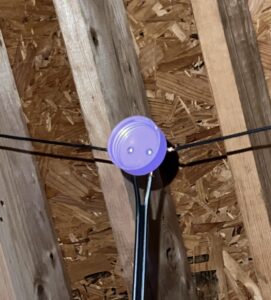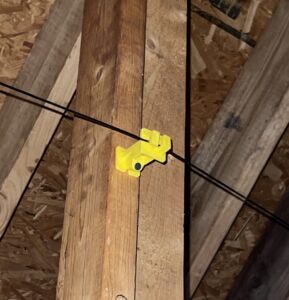My Attic Antenna
Antenna discussions have been going on for years and will continue on. Included in these discussions is the subtopic of attic antennas. This page will show what I have done and thoughts for what I may do in the future. Every situation/attic has its own set of challenges and should be dealt with accordingly.
My operating:
As stated elsewhere in my site I operate ~95% CW. The other ~5% is digital and my annual attempt at an SSB contact. Also, I operate my main radio at the 25 watt level and my low power radios at from 1.5 to 5 watts. Does my attics antenna work? Short answer – yes. Do I work DX with my attic antenna? Yes (no pileup busting). Would I like full size resonant antennas outside at the proper height instead? Yes.
My antenna situation:
During the fourth quarter of 2016 we downsized to a smaller home. The house needed a new roof so in case my plans for an outside antenna in our very tiny lot failed (they did) the roofing material was very important. So much so the color and style meant little to me (not so to my wife), but the martial contained in the shingles was number one. Other than nails, wiring and duct work our attics is metal free.
I tried ham sticks as verticals and in a dipole configuration – then moved on. I then tried doublets of various length with a tuner in the attic. The doublets worked much better than the ham sticks. However, up and down the attic ladder to tune the antenna was not ideal.
My doublet is use today was taken from the DX Engineering website “On All Bands.” It is 55 feet long fed with a short piece on 300 ohm twin lead to a 1:1 balun. A short piece of low loss coax runs from the balun to an LDG remote tuner. The tuner is in a storage area on the second floor (top floor) to stay away from the Georgia heat in the attic (still warm in the storage area). Click for a drawing of the doublet. The coax run to the radio is short as the shack is also on the second floor.
The pictures below are of components of my antenna. There is only one single strand of 18 gauge coated wire. The apparent double wire is a shadow from the camera flash. Left click to enlarge for a better view.
Points to note:
- 18 gauge coated wire was used.
- I use electric fence standoffs to hold the doublet on the rafters.
- The antenna is bent to fit the space available in the attic.
- The tuner is powered by DC voltage injected into the coax feed line.
Thoughts for the future:
- Increase the length of the Doublet – more bending required
- Wire loop around the perimeter of the attic
- Linear loading
Conclusion:
Attic antennas are not ideal, but they do work. The process is forever evolving and will continue at my QTH. Given the choice there are a lot of better ways to get on the air than using attic antennas, but it is better than going QRT.
Unlike me, do a better analysis before downsizing.

